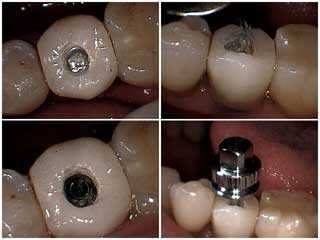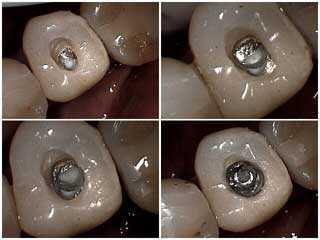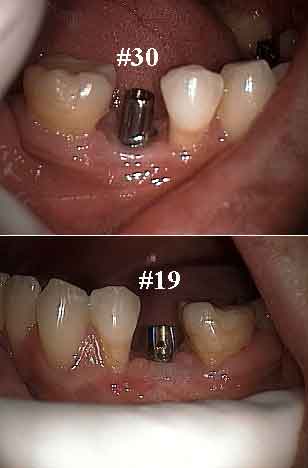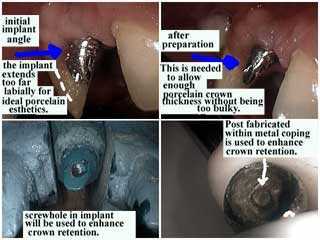Before and after photos on dental crowns for teeth implants and abutment screws performed in our dental implants office.

Tightening a loose second stage screw through a dental crown cemented on a single dental implant. The porcelain crown was loose but the implant itself was solid. You need to differentiate this in advance. Use copious water irrigation with an air-water syringe in addition to handpiece water. 1) Drill through occlusal porcelain into metal. 2) Prep through metal to expose the tiny temporary wax bead which overlays the slot in the second stage screw. (Place the wax bead before cementation to prevent the cement from filling the screw slot which would prevent being able to ever turn the screw again). 3) Access through crown shows second stage screw. 4) Implant screwdriver in place tightening the screw. Close this access opening with a tiny bead of wax and then composite in the occlusal. You could consider designing crowns for single tooth implants with the access already prepared directly to the second stage screw. This would make getting to the screw much easier should the need arise. Always torque second stage screws to the manufacturers specification.

Gaining access to a loose second stage screw through a dental crown cemented on a single dental implant. The tooth crown was loose but the implant itself was solid in bone. You need to differentiate this in advance. Use copious water irrigation with an air-water syringe in addition to handpiece water. Photo 1) Prep – drill – through occlusal porcelain into metal. Photos 2) and 3) Prep through metal to expose cement layer between crown and implant abutment. Photo 4) Access through crown shows a second stage screw covered by a cotton pellet. Close this access opening with a wax bead instead since it won’t absorb saliva and then composite in the occlusal. You could consider designing crowns for single tooth implants with the access already prepared directly to the second stage screw. This would make getting to the screw much easier should the need arise. Always torque abutments to manufacturer’s specification.

Two single-tooth dental implants ready for porcelain crowns. Implants may be considered artificial tooth roots on which porcelain crowns are cemented.

The initial dental implant abutment extends too far labially for ideal porcelain aesthetics. Drilling off part of the implant abutment now provides enough room for the ideal porcelain crown thickness. The screwhole in implant is used to enhance crown retention.
The post fabricated within the metal coping is used to enhance crown retention.
The post fabricated within the metal coping is used to enhance crown retention.